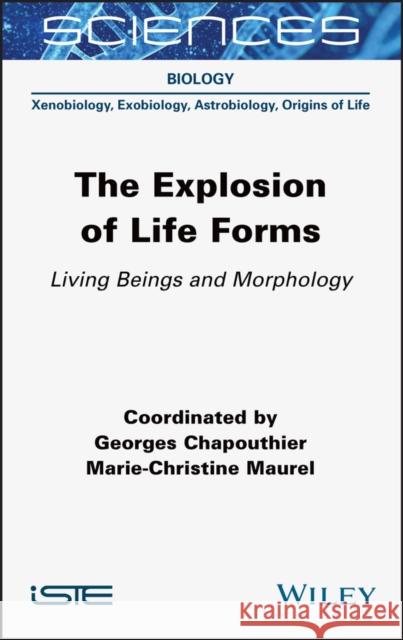The Explosion of Life Forms: Living Beings and Morphology » książka



The Explosion of Life Forms: Living Beings and Morphology
ISBN-13: 9781789450057 / Angielski / Twarda / 2021 / 256 str.
The Explosion of Life Forms: Living Beings and Morphology
ISBN-13: 9781789450057 / Angielski / Twarda / 2021 / 256 str.
(netto: 638,23 VAT: 5%)
Najniższa cena z 30 dni: 666,00
ok. 30 dni roboczych
Dostawa w 2026 r.
Darmowa dostawa!
Introduction xiGeorges CHAPOUTHIER and Marie-Christine MAURELChapter 1. Possible Traces and Clues of Early Life Forms 1Marie-Christine MAUREL1.1. Introduction 11.2. Have "things" always been as they are today? 21.3. Fossil traces? 41.4. Geochemical elements confirming these recent results 61.5. Compartmentalization of resources and primary biomass 91.6. Rebuilding a living cell: a wide range of possibilities explored, from the mineral to the organic 121.7. Conclusion 131.8. Acknowledgments 141.9. References 14Chapter 2. The Nature of Life 19Andreas LOSCH2.1. Observations and assumptions 202.2. Descriptions and definitions 212.3. Exploration 232.4. Conclusion 252.5. References 26Chapter 3. From Form to Function 29Jean-Pierre GASC3.1. Form: a concept for knowledge 293.2. Basic structural elements: from the molecule to the cell 313.3. The weight of the physical setting 343.4. Mesoderm: base material for architect genes 353.5. Appendices and laws of mechanics 373.6. "Appendicular" movement on land 403.7. The legless 443.8. And the head 443.9. References 47Chapter 4. On Growth and Form: Context and Purpose 51Jean-Pierre GASC4.1. D'Arcy Thompson's program 544.2. Application of mathematics to morphometry 594.3. References 61Chapter 5. The Emergence of Form in the History of Epigenetics 65Jonathan B. WEITZMAN5.1. Introduction 655.2. From epigenesis to epigenetics 665.3. The evolution of the epigenetic landscape 685.4. Modernizing the epigenetic landscape 705.5. From epigenetic landscape to chromosome conformation 725.6. Conclusion: from form to function 755.7. Acknowledgments 765.8. References 76Chapter 6. The Many Shapes of Microbial Detection of Kin and Kind 79Guillermo PAZ-Y-MIÑO-C and Avelina ESPINOSA6.1. From Darwin's social-insects-puzzle to microbes 806.2. Handshakes of kinship or "kindship" in bacteria 816.3. The ameba world of clone discrimination/recognition 856.4. Social microbes and multicellularity 886.5. Conclusion 956.6. References 95Chapter 7. Development and Evolution of Plant Forms 101Florian JABBOUR and Guilhem MANSION7.1. Introduction 1017.2. Diversity of plant forms and associated functions 1027.2.1. Anthropocentric view of plant forms 1027.2.2. Plant forms perceived by pollinators 1037.3. Origin and evolution of plant forms 1047.3.1. Pattern formation during ontogenesis 1047.3.2. Physical-mathematical considerations on plant morphogenesis 1057.3.3. Implementation of forms during phylogenesis 1077.4. Origin and evolution of plant forms 1127.4.1. Usefulness for human societies 1127.4.2. Usefulness for botanical classifiers 1147.5. Conclusion 1187.6. Acknowledgements 1187.7. References 118Chapter 8. Forms of Memory 125Robert JAFFARD8.1. Introduction 1258.2. The polymorphism of memory 1268.3. Non-associative memories 1278.3.1. Habituation and sensitization 1278.3.2. Priming 1298.3.3. Perceptual learning 1308.4. Classical conditioning 1318.4.1. Operational definition, rules and varieties of classical conditioning 1318.4.2. Contemporary theory of classical conditioning 1328.4.3. The importance of classical conditioning 1338.5. Instrumental conditioning 1348.5.1. Law of effect, stimulus-response (S-R) theory and "habits" 1348.5.2. From S-R theory to cognitive theories 1358.5.3. The two facets of instrumental conditioning 1368.6. Procedural memory as a "memory system" 1378.6.1. Habits: double functional dissociations in mammals 1378.6.2. Human procedural memory and its cerebral supports 1398.7. Declarative memory 1408.7.1. Episodic and semantic memory: definitions, properties and relationships 1418.7.2. Episodic memory in animals? 1438.8. Short-term memory and working memory 1448.8.1. General characteristics 1448.8.2. Models 1448.8.3. Short-term memory in animals 1468.8.4. Cerebral substrates 1478.9. Conclusion: organization and reconfiguration of the different forms of memory 1478.10. References 150Chapter 9. The Construction of Sensory Universes 155Dalila BOVET9.1. Introduction 1559.2. Chemoreception 1569.2.1. Taste 1569.2.2. Smell 1589.3. Mechanoreception 1599.3.1. Touch 1609.3.2. Lateral lines 1609.3.3. Hearing 1619.4. Electromagnetoreception 1639.4.1. Vision 1639.4.2. Electroreception 1659.4.3. Magnetoreception 1669.4.4. Thermoreception 1679.5. Information filtering 1679.6. Conclusion 1709.7. References 172Chapter 10. Emotional and Social Forms of Robots 173Laurence DEVILLERS10.1. Introduction 17310.2. Communication with social and emotional robots 17510.3. Human empathy for machines 17610.4. Machine emotions 17810.5. Conclusion: risks and benefits 18010.6. References 181Chapter 11. When Medical Technology Mimics Living Forms 183Didier FASS11.1. Introduction 18311.2. Historical and epistemological perspective 18411.2.1. A comparative history of medical technology 18411.2.2. Epistemological perspective 18911.2.3. A conceptual and theoretical framework: the mathematical theory of integrative physiology (MTIP) by Gilbert Chauvet 19311.2.4. Forms of thinking or processing by machines 19611.3. Simulation, biomimetics and bioprinting: a future for medical technology 19611.4. References 199Chapter 12. From Living to Thinking: Mosaic Architecture 203Georges CHAPOUTHIER12.1. Introduction 20312.2. Two main principles 20312.3. Genes and cells 20412.4. More complex anatomical mosaics 20612.5. Epistemological rehabilitation of asexual reproduction 20712.6. Social mosaics 20812.7. Encephalic mosaics 20812.8. Mosaics of thought 21012.9. Man-made objects 21312.10. Human and animal cultural traits 21412.11. A universality of mosaics? 21512.12. Conclusion: philosophical foundations 21612.13. References 217Chapter 13. Converging Technologies or Paradoxes of Power 221Jean-Michel BESNIER13.1. Introduction 22113.2. Might, domination, power 22313.3. Life, technique, power 22413.4. "Technological arrogance" 22713.5. Technological convergence and singularity 22813.6. Innovation, research, invention 23013.7. Conclusion 23113.8. References 231List of Authors 233Index 235
Georges Chapouthier is a biologist, philosopher and Emeritus Director of Research at the French National Centre for Scientific Research (CNRS) in France. His research interests focus on animals and the brain.Marie-Christine Maurel is a Professor at Sorbonne University and a researcher at the Institut de Systematique, Evolution, Biodiversite laboratory at the National Museum of Natural History in France. Her research interests focus on the origins of life, RNA, viroids and molecular archeobiology.
1997-2025 DolnySlask.com Agencja Internetowa
KrainaKsiazek.PL - Księgarnia Internetowa









